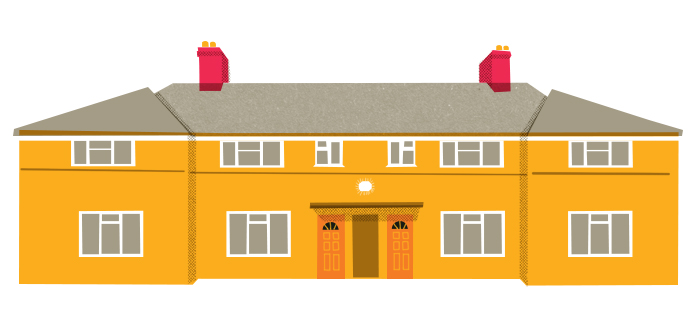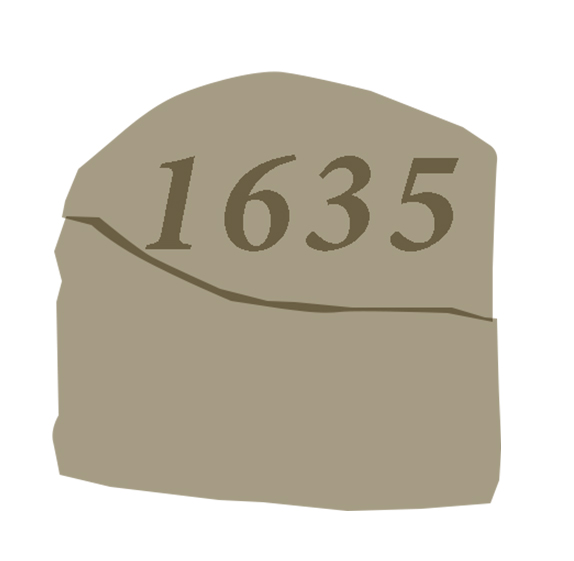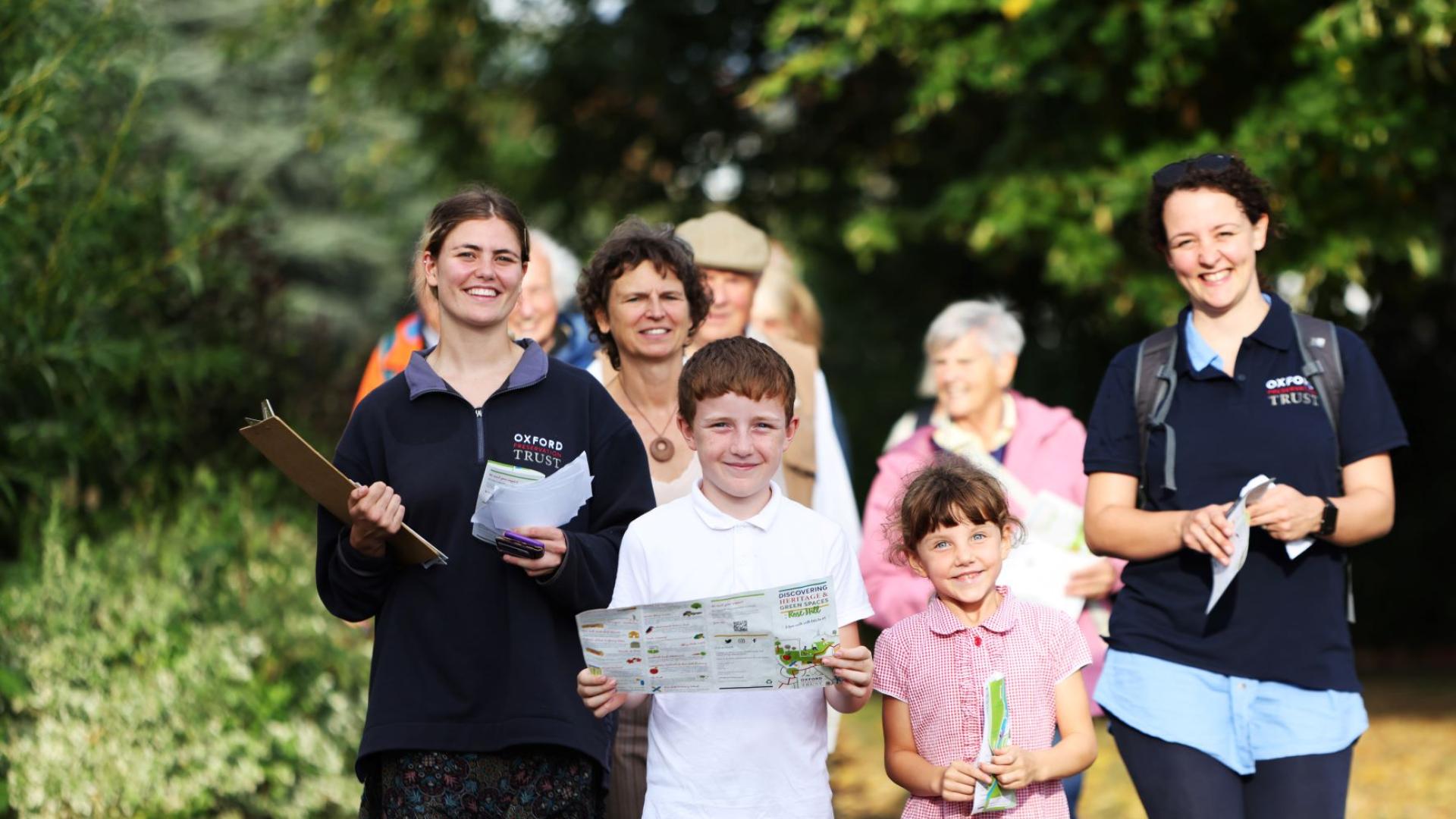Discovering Heritage & Green Spaces
Discovering Heritage & Green Spaces is a chance to Connect Communities with their Heritage. The project came about as a result of the COVID-19 Lockdown, when OPT released a series of very successful self-guided walks which were used by many local Oxford residents. We wanted to continue the success of this project, helping to promote exercise and wellbeing whilst also celebrating the heritage of communities and areas outside the city centre.
With funding from Oxford City Council's #WeAreOxford Bid, we were able to turn this idea into a reality.
Working together with the community
Rose Hill was chosen as the pilot location for our Discovering Heritage & Green Spaces project, as the area has a fascinating industrial past, and a deep-rooted sense of community. Through this project, OPT were able to learn more about Rose Hill's interesting history and heritage with help from local historian Liz Woolley, who compiled a 63-page report on the area's past.
To help dictate the path of the walk, OPT also held several engagement events with local community groups and individuals. We are very grateful to all residents who came along and shared with us their experience, memories and favourite places within Rose Hill.
Rose Hill Community Centre

The first Rose Hill Community Centre was a large wooden structure costing £400 built on the corner of Ashhurst Way and Spencer Crescent in July 1937 in response to a need for social facilities. The community centre was the first of its kind in the city and covered its costs by putting on dances and other events, managed by a committee of local residents. The first community centre burnt down in 1955 and was replaced with a new brick building on the Oval, which opened in 1956. The current Community Centre was opened in 2016 by Bill Buckingham, the spokesperson for the Rose Hill Community for 40 years. The community centre went on to win an OPT Award later that year.
Rose Hill Playing Field

Behind the community centre sits the Rose Hill Playing Fields and Recreation Ground. These green, communal areas provide plenty of open space used by families, dog-walkers, children playing and local groups & clubs.
"I love the rec in Summer - all ages and backgrounds playing together"
"Georgian" Townhouses

Townhouses on Rowney Place, Spencer Crescent, Dashwood Road and Ashhurst Way were built as part of the first Rose Hill Estate, called "Rose Hill No. 1 Estate," which was completed in 1935. By March 1937 the City Engineer had prepared plans for the Council’s Rose Hill No. 2 Estate, immediately to the south of No. 1 Estate. Ashhurst Way was extended westwards and Spencer Crescent southwards, and new roads called Fiennes, Asquith, St Martin’s, Jersey, and Devereux Place laid out. Buildings were strategically designed to avoid resembling Oxford's Victorian Suburbs or the "cramped courtyards" of the city centre. The buildings were instead built in a Georgian-style of Architecture, and each terrace was treated as one building, not divided vertically into units, but rather with horizontal lines emphasised. Access passageways added symmetrical or central accents to the building; the chimneys on the roof, and even the drainpipes, reinforced its symmetry.
Rose Hill Methodist Church

The Rose Hill Methodist Church was first built in 1835 by by Henry Leake, a gentleman of means who lived with his mother in a house on Church Way in Iffley village. On first moving to Iffley in 1833, Leake had joined a group of Methodists who held their services in a Mr Gordon’s cottage. The group soon outgrew the cottage and after holding their services in a stable in a tanner’s yard for some time, it was decided to find a site for a new chapel. Henry Leake leased a site on the London to Henley Road at Rose Hill from an Oxford print seller, Thomas Taylor, and the laying of the foundation stone took place in June or July 1835. The chapel had a burial ground, an unusual feature for a village chapel. This was because the then vicar of St Mary’s Church in Iffley had raised objections to allowing one of the Methodist group, a Brother Dyer, to be buried in the churchyard there, and so the Methodists decided that they needed a burial ground of their own. The earliest recorded burials at Rose Hill date from 1842.
Oxford's Oldest Highway Stone

Although this stone is quite difficult to spot along the western side of the road called Rose Hill, it dates back to 1635, making it the oldest highway stone in Oxfordshire, and one of the oldest in the country. It is also listed Grade II, and has an inscription which reads: HERE [ENDETH] IFLY HY WAY 1635. The highway stone originally marked the main road between Oxford to London via Henley, on which the settlement of Rose Hill was established. Slightly further down the road outside 37 Rose Hill, another highway stone dates from 1736. This was when the London–Henley–Oxford road was turnpiked, and this was the last milestone before the road reached its destination at the toll gate at the Plain, a mile further north.
Parade of Shops

Rose Hill No. 1 Estate left vacant the main road frontage, which was subsequently decided by the Housing Committee to be turned into a parade of shops and 32 flats, some specifically for older people. The parade buildings are thoughtfully designed, with deep roofs, stone-clad semi-circular turrets (giving access to the flats above the shops) and decorative half-timbering and brickwork panels. In around 1961, 90 Rose Hill was Kandies confectioner’s shop and no. 92 was D Morgan’s bakery.
"A great local resource for the community"
Great Gardens!

The City Council’s Planning Office took great care over the layout of the roads, street lighting, sewers, and drains in Rose Hill's first estates. To ensure that houses got enough sunlight, there was seventy feet between them across the street, and there was a very low density of houses to the acre. To provide a pleasing street picture and to avoid the long straight rows of uniform terraces which characterise Oxford’s Victorian suburbs, roads were curved rather than on a rectilinear grid, and open green space, grass verges, and trees were incorporated in the design. These had shared open green spaces in front of them, markedly different from the front gardens on contemporary privately-built estates, which were separated into private areas with hedges and fences. Despite the fact that the council estate housed many car factory workers, particularly after the Second World War, the houses were planned for people without cars, and so there were no garages or off-street parking spaces; car ownership did not become widespread until the end of the 1970s.
Littlemore Roundabout Underpass

Littlemore Roundabout Underpass is one of the legal graffiti walls around Oxford, and a great place to find beautiful street-art murals created by local artists. The artwork changes often, so go take a look for yourself!
Path by the Eastern By-Pass Road

"This path is wonderful in Springtime when the blossoms and leaves are first emerging after Winter"
Ancient Oak Trees

In the medieval period the Rose Hill area was mainly open fields, however one area of Rose Hill remained wooded for over 1,000 years: the Grove. This existed before the Norman Conquest and was mentioned in the Domesday Book as an area of coppice, and later in a 13th -century deed. Remarkably, three oak trees from the Grove still remain in the modern estate, on Rivermead Road, plus another further north on the corner of Mortimer and Nowell Roads.
Queen Mary Trucks

In the Post-War Estate which was constructed between 1946 and 1949, several different types of houses were constructed. Flats were mostly built traditionally, of brick and slate, but the houses were nearly all prefabricated, such as those on Lambourn Road. There were four other main types of houses on the post-war estate, which took their names from the companies which produced them: Howard houses, Orlit houses, Glen Lyon bungalows, and Minox houses. The Howard houses were factory-made and of sturdy construction, with iron girder frames faced with steel cladding .They were brought on to the site on RAF transporters called ‘Queen Marys’ which were normally used for carrying aircraft.
Rivermead Nature Park

Rivermead Nature Park is a firm favourite with Rose Hill Residents, which sits to west of the estate and has been leased by Oxford City Council from the University of Oxford since 1990. It is a mosaic of lowland, mixed deciduous woodland with elements of calcareous alkaline fen, wet woodland, a stream, drains, rough grassland, scrub and a pond, all on a gentle slope down to the eastern margin of the River Thames. It is managed in partnership with the Berkshire, Buckinghamshire & Oxfordshire Wildlife Trust (BBOWT). In the 1950s this area was home to the track of the Baskerville Hounds, Rose Hill’s popular and successful cycle speedway team.
Toads Crossing!

"Toads are often seen hopping between Lenthall Road and Eastchurch"
Iffley Glebe Field

Nearby to Rose Hill sits Iffley Glebe Field, which has been owned by Oxford Preservation Trust since 1996. The Glebe preserves Iffley's rural feel and provides ancient habitat for voles, insects, birds, bats, owls and more! Find out more about Iffley Glebe Field HERE.
Lenthall Road Allotments

The Lenthall Road Rose Hill Allotments have been in place since 1947. The 6.7-acre site slopes westwards towards Iffley village, with views over Iffley church to Boars Hill and beyond. There are 88 ‘10-pole’ plots, each measuring about 7 yards by 35 yards (many of which are divided into half or quarter plots), a shop, a children’s play area and two wildlife areas.
Community Orchard at Rose Hill Primary

Behind Rose Hill Primary sits the Community Orchard which was created by the Rose Hill and Iffley Low Carbon Group, who promote renewable energy, energy conservation, waste reduction and tree planting. They have planted over 600 trees on the Rec, involving representatives from 16 local community groups, as well as successfully advocating for the installation of 190 solar PV panels on the roof of the Rose Hill Community Centre, and 109 more on the roof of Rose Hill Primary School. They currently run regular Repair Cafes and Swap Shops in Rose Hill.
The Oval

The Oval and the radiating roads were established in 1945 onwards, and has been home to many important Rose Hill Buildings including the old Community Centre, the Primary School and the new social housing scheme which was completed in 2021.
Rose Hill Primary School

After the Second World War, several junior mixed schools were established in the outer suburbs including, in 1950, Rose Hill Primary School on the Oval. The showpiece buildings created interest form far and wide and attracted delegations from Denmark, Switzerland, Sweden, Germany, Australia and British Guiana. The official opening took place on 10 July 1952, where John Christi, Principal of Jesus College, surprised the 200 parents and 80 official guests assembled in the hall with his view of the new school: he said that Westminster and Winchester, two public schools where he had been headmaster, could not boast such fine classrooms as Rose Hill. In September 1952, a new school uniform was introduced in maroon and turquoise (later changed to navy), with caps for boys, berets for girls, and badges and ties for both.
Rose Hill War Memorial

In 1923, a war memorial to soldiers of the Oxfordshire & Buckinghamshire Light Infantry (OBLI) who had died in the First World War was erected on the eastern side of Rose Hill at its junction with Church Cowley Road. It was originally proposed that the regimental memorial should be sited close to the Ox & Bucks barracks at Bullingdon Green in Cowley, but no suitable site could be found, and so instead it was built on a triangle of land at Rose Hill donated by Christ Church. The location was chosen specifically so that the memorial could be seen against the sky. It was designed by Sir Edwin Lutyens and unveiled on Remembrance Day in 1923.
Rose Hill Cemetery

In the early 1890s land to the north-east of Rose Hill was given over to one of three new municipal cemeteries, in response to the pressing need for new burial grounds. Originally in 1883, the cemetery committee of the Local Board resolved to buy 26 acres of land at Rose Hill from Christ Church. However, disagreements on price dragged negotiations on until 1889. Instead, land for three smaller cemeteries were purchased at Rose Hill (11 acres), Cutteslowe (13 acres) and Botley (8 acres). Each site had an appointed superintendent, a chapel, caretaker’s house, office, entrance gates, a surrounding iron fence, and grave spaces divided into sections by cast iron standards with figured and lettered labels attached; the total cost was approximately £25,000. The cemeteries were opened on 12 March 1894. By the time Rose Hill Cemetery was consecrated in 1901 there had already been 382 burials. It now contains 19,743 burials, including 28 Commonwealth graves from First World War and 58 from the Second World War.

